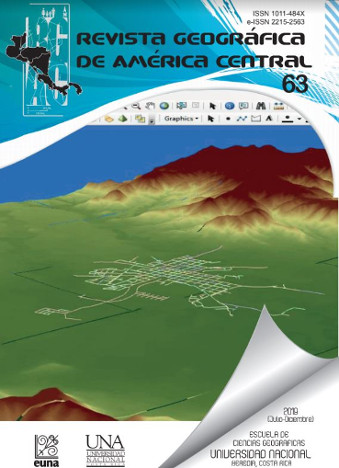Use of agrochemicals in the seating three pontes, Perolânia (go) Municipality: risk to health factors
DOI:
https://doi.org/10.15359/rgac.63-2.14Keywords:
Agrotoxic; Settlement; Health; Environment; AgricultureAbstract
In this study, a total of forty-three of the twelve settlements were interviewed in the Settlement of Three Bridges, which corresponds to 27.9%. The study also analyzed the use of pesticides in the study area belonging to the municipality of Perolândia (GO), with views to reveal the impacts of these products on public health. The age range of the subjects varies from 35 to 70 years, being able to affirm that it is an adult population. The level of schooling 72.7% is incomplete. Reality that interferes when you think chemicals require a degree of understanding to handle them. For Florêncio et. Al. (2001), "Most workers state that they are not able to understand the instructions and recommendations contained in product labels" (Florêncio, et al. 2001, p. 51). We investigated the use of Personal Protective Equipment (PPE); the knowledge about the agronomic recipe, a mandatory item in the acquisition of these products, and the correct disposal of empty containers. The results showed that of the twelve lots visited 90.9% recognize the importance of the EPis, but they do not use it, all are not aware of the agronomic prescription and 30% outsource the pesticide control of their properties. It is a qualitative research, opting for field study. Data collection instruments were used: the observations, the application of questionnaires and semi-structured interviews. The subjects were the families settled in the Settlement Three Bridges, presenting the reality of this community, about their way of life and mainly the influence of pesticides in their productive activities, as well as their awareness and safety in their use. It was verified that in the researched settlement families use agrochemicals indiscriminately in their crops.
References
Alves, J. P. (2002). Uso de Agrotóxicos no Brasil: Controle Social e Interesses Corporativos. São Paulo, Annablume: Fapesp.
Brasil (2015), Ministério da Saúde, disponível em: www.ministeriodasaude.go.gov.br. Acesso em: nov.
Brasil (2015), Lei nº 7.802, de 11 de julho de 1989. http://www.planalto.gov.br/ccivil_03/leis/L7802.htm. Acesso em 18.nov.
Brum, A.J., (1988) Modernização da Agricultura: Trigo e Soja, Petrópolis: Vozes,.
Carneiro, F. F., Augusto, L.G.S., Rigotto R.M., Friedrich, K. Campos, A. B., (2015) Dossiê ABRASCO: Um alerta sobre os impactos dos agrotóxicos na saúde. Rio de Janeiro, abril.
Carson, R. (2010), Primavera Silenciosa, 1907-1964-Traduzido por Claudia Sant’Anna Martins. Ed. SP: Gaia.
Castro, J, (2008). Geografia da fome. Rio de Janeiro: Civilização Brasileira.
Coelho, C. N. (jul./ ago./ set 2001). 70 anos de política agrícola no Brasil (1931-2001). Revista de Política Agrícola, Brasília, 3, 3-58, (Edição especial).
Grissolia, C. K. (2005). Agrotóxicos: mutações, reprodução e câncer. Brasília: Editora Universidade de Brasília.
Fonseca, M. F. A. C.; colnago, N. F.; silva, G. R. R.; Fonseca, P. T (2010). Agricultura orgânica: regulamentos técnicos da produção animal e vegetal. Programa Rio Rural, Manual Técnico, v. 29.
Ferrari, A. (1986), Agrotóxicos: a praga da dominação. 2ª ed. Porto Alegre, Mercado Aberto.
Ferrari D. (2016), Agricultores familiares, exclusão e desafios para inserção econômica na produção de leite em Santa Catarina. Informações Econômicas, São Paulo, v.35, n.1, jan. 2005. Disponível em http://www.iea.sp.gov.br/out/publicacoes/pdf/tec2-0105b.pdf. Acesso em: 25 fev..
IBGE-cidades (2010). hhttp://www.cidades.ibge.gov.br/, acesso em 20. nov..
Marques, M. I. M. (2004). Lugar do Modo de Vida Tradicional na Modernidade. In. Oliveira, Ariovaldo Umbelino de; Marques, Marta Inez Medeiros (orgs.). O Campo no Século XXI: território de vida, de luta e de construção da justiça social. São Paulo: Casa Amarela e Paz e Terra, (p. 145-158).
Nishiyama, P. (2003) Utilização de agrotóxicos em áreas de reforma agrária no Estado do Paraná – Tese de Doutorado, Fundação Oswaldo Cruz- Campinas, SP.
Oliveira, A. U. (2007), Modo de Produção Capitalista, Agricultura e Reforma Agrária. São Paulo: Labur Edições, 2007, 184p.
PignatI, W.A.(2007), Os riscos, agravos e vigilância em saúde no espaço de desenvolvimento do agronegócio no Mato Grosso [tese de doutorado]. Rio de Janeiro: Fiocruz/Ensp.
Ribeiro, D. D.(2003), Modernização da agricultura e (re) organização do espaço no município de Jataí – GO. Dissertação de mestrado em Geografia - Universidade Estadual Paulista, Faculdade de Ciências e Tecnologia. Presidente Prudente: [s.n.], 96 f.
Downloads
Published
How to Cite
Issue
Section
License
Proposed policy for journals offering Open Access
Authors publishing their works in the Journal acknowledge and agree to the following terms:
a) Authors retain the copyrights to their works and guarantee the Journal the right to be the first to publish their works, under the Creative Commons License Attribution-NonCommercial-ShareAlike 4.0 International, CC BY-NC-SA 4.0 International (https://creativecommons.org/licenses/by-nc-sa/4.0/deed.es), which allows others to share works upon complying with the acknowledgment of authorship and mention of the Journal as the original publisher of the work.
b) Authors are permitted to separately establish additional agreements for the non-exclusive distribution of the official edition of the work published in the Journal (for example, authors may desire to place the work in an institutional repository or incorporate it into a book that is to published elsewhere) so long they acknowledgment to recognize the Journal as the original publisher. The aforementioned additional agreements must respect the terms of the non-profit character and sharing philosophy of the original license (CC BY-NC-SA 4.0 International, https://creativecommons.org/licenses/by-nc-sa/4.0/deed.es).
c) Authors are encouraged to archive the post-print or editor/PDF version in Open Access repositories.






 REVGEO is licensed under https://creativecommons.org/licenses/by-nc-sa/4.0/deed.es
REVGEO is licensed under https://creativecommons.org/licenses/by-nc-sa/4.0/deed.es
.svg_4.png)

_(1).png)
_(1)_(1)_(1)_1.png)
(2)(1)(1)(1).png)
